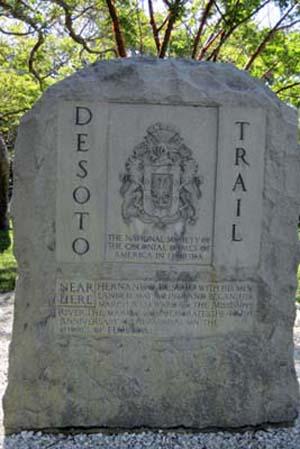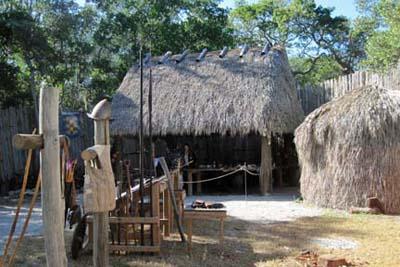Hernando de Soto was a brutal man. In his 4,000-mile trek, he and his men overwhelmed Indian villages, took many Indians as slave porters, and destroyed native cultures.
In 1539, de Soto sailed from Cuba into Tampa Bay on the West Coast of Florida. He brought with him more than 700 men, two women, 200 horses, and war dogs. His goal was to explore Florida, but mostly to find gold. De Soto was the ultimate entrepreneur; he planned and financed the expedition himself. He was already a rich man, having taken part in the Spanish conquest of Peru.
But the wealthy, idle life in Spain didn't suit him and he was ready to invest his whole fortune to plunder Florida. He was driven to succeed. If he returned without gold, he would be a failure and have lost all his money.
De Soto National Memorial outside of Bradenton, Florida, interprets this history in a lively manner on a site that covers less than 30 acres. One challenge the National Park Service had to confront was that there is nothing original left from the expedition. In addition, it's not clear exactly where the de Soto expedition actually landed. As Ranger Diana Bauman explains, "You can't put an X on where they landed."
There's a lot to do at the site, so let me give you some pointers.
See The Film
A 21-minute film, as narrated by a survivor, reenacts the expedition. There are first-person accounts of the expedition. It starts as de Soto's party lands on May 30, 1539. Indians watch the Spanish come ashore.
In their metal armor, the soldiers crash through the mangrove swamp. Early on his march, de Soto comes upon a Spaniard who had been taken prisoner by Indians years ago and can now act as an interpreter.
Together with his many men, de Soto keeps going north looking for gold and fighting Indians. They aren't searching for gold mines, but for treasures that the Indians already possess.
As the film reminds us, 'there was cruelty on both sides.' The march shown on a map looks like a long strand of cooked spaghetti. They went up to present-day Tallahassee, up into South Carolina, then crossed the Appalachian Mountains in North Carolina and down to Mobile, Alabama. They crossed the Mississippi River.
De Soto died of fever in 1542 and was buried in the river. The survivors eventually floated down the Mississippi and made their way back to Cuba.
The film sums up the expedition this way: De Soto didn't find gold, didn't create any settlement, but the accounts of nature and native people encouraged future expeditions. The film is well done except for the morning glories that are very noticeable in the landing scene. Morning glories are invasive flowers from Asia that probably were not growing in American in 1539.
Visit the Living History Camp
Under a thatched roof stand, a volunteer in Spanish dress demonstrates various weapons and tools of the times. A conch shell on a stick was used as a hammer or hatchet. She blows into the conch as Indians might have done to alert the villagers. "A kind of telephone of the times," she explains. A long musket, called an arquebus, was the Spanish weapon of the era. The volunteer explains that this gun was made up of a lock, stock, and barrel. From this gun, we get the expression, lock, stock, and barrel.
Another volunteer dresses visitors in Spanish war dress. Lenny, my husband, puts on a chain mail pullover. Over that goes the steel armor. He's helped into metal gloves called gauntlets. On his head, he wears a cabisset, a metal helmet. "Now I understand why the soldiers needed to have others carry their supplies," he says. "This is heavy."
Walk the Trail
The site offers a one-mile interpretive trail along the shoreline of the Manatee River and the mangrove swamp. There are benches and wayside signs to explain the expedition and the natural environment.
The trail ends just outside the park. There the Catholic Diocese of Venice, Florida, has erected a Holy Eucharist monument and memorial cross dedicated to all priests who served in Florida, starting with the 12 priests who came with de Soto's expedition.
See the Commemorative Stone
The site has a magnificent gumbo limbo tree with spreading branches. The tree is known as the tourist tree because 'it stands in the sun, turns red, and peels.'

The commemorative stone placed by the Colonial Dames. Danny Bernstein photo.
Under this tree stands a Commemorative Stone put up by the Colonial Dames in 1939, the 400th anniversary of the De Soto landing, in honor of his arrival. The stone was placed over an Indian burial mound to preserve it. In 1948, Congress created the De Soto National Memorial.
'Women married to influential men preserved a lot of land,' Ms. Bauman explained, referring to the Colonial Dames.
The stone is also the beginning of the De Soto Trail, a driving trail that takes visitors from the national monument to 34 sites in Florida connected with the expedition. Visitors can pick up a detailed booklet with directions to each stop.
That's a lot of activities to pack in a 30-acre site. Historians David and Anne Whisnant, who wrote the administrative history of the park, explain the challenges of interpreting the events that occurred in the vicinity in a previous Traveler article. They point out that the site gets a large number of visitors for such a small place. One explanation for the popularity might be that locals use it as a town park for dog walking and jogging. It is probably also popular with school groups from Tampa and surrounding cities.
According to our own Professor Bob Janiskee, De Soto National Memorial has the distinction of being the park unit that commemorates the earliest event in American history. "There's a place in the National Park System that was visited by Christopher Columbus, Salt River Bay National Historical Park and Ecological Preserve in Christiansted, Virgin Islands, but the park wasn't created specifically to commemorate that event," Bob said.
This distinction might not be enough for most visitors to make De Soto National Memorial a destination park, but if you're driving the west coast of Florida, it's definitely worth a few hours of your time.




Add comment